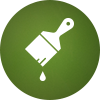When installed and used properly, rain barrels can be a safe and efficient way to capture a valuable resource that would otherwise be lost to storm drains. In the simplest terms, rain barrels collect water from rooftops and store it for later use.
What is a Rain Barrel?
 Rain Barrels are specifically designed or adapted containers that hold between 40 and 80 gallons of water. These unique home devices come in a variety of different styles, from pre-manufactured designs made from recyclable materials to wooden barrels or other instruments that have been adapted to capture water.
Rain Barrels are specifically designed or adapted containers that hold between 40 and 80 gallons of water. These unique home devices come in a variety of different styles, from pre-manufactured designs made from recyclable materials to wooden barrels or other instruments that have been adapted to capture water.
How Much Does a Rain Barrel Cost?
 Industrially manufactured rain barrels can cost up to $120 but many homeowners have found workarounds to secure a rain barrel for much less. You can download a step-by-step guide to constructing your own rain barrel here.
Industrially manufactured rain barrels can cost up to $120 but many homeowners have found workarounds to secure a rain barrel for much less. You can download a step-by-step guide to constructing your own rain barrel here.
Some watershed associations, garden clubs, and local government agencies also offer reduced pricing on rain barrels or rain barrel kits to encourage their use. It’s also worth checking with local bottling companies or drum manufacturers to see if they sell or donate used or excess barrels. Local governments often augment these types of programs as well. For example, the City of Tampa promotes Rainwater Harvesting Workshops taught by a local cooperative to teach citizens how to use their rain barrel as well as other issues around sustainability.
Why Use a Rain Barrel?
 Diverting runoff from a home’s roof reduces the amount of storm water that enters storm sewers, and consequently empties out into local rivers, lakes, and streams. Using a rain barrel provides a wide variety of benefits to homeowners and their communities, including:
Diverting runoff from a home’s roof reduces the amount of storm water that enters storm sewers, and consequently empties out into local rivers, lakes, and streams. Using a rain barrel provides a wide variety of benefits to homeowners and their communities, including:
- Diverting stormwater back into the landscape
- Conserving tap water and energy use
- Lowering water and utility bills
- Helping to control local flooding
- Protecting rivers and streams from erosion and overfilling
- Keeping pollutants from entering local waterways
- Helping to reduce the need for sewer upgrades or maintenance
How Rain Barrels Work
 The most essential function of a rain barrel is to store water in a large container, but there are other design factors to consider. Traditional rain barrels have a spigot attached to the bottom of the container that can be attached to a garden hose to use for watering plants, flowers, crops or your lawn. Most rain barrels also have an overflow device to route superfluous water away from a home’s foundation. Because rain barrels have better water pressure when they are full, elevating or tilting the barrel can help the water to drain more easily.
The most essential function of a rain barrel is to store water in a large container, but there are other design factors to consider. Traditional rain barrels have a spigot attached to the bottom of the container that can be attached to a garden hose to use for watering plants, flowers, crops or your lawn. Most rain barrels also have an overflow device to route superfluous water away from a home’s foundation. Because rain barrels have better water pressure when they are full, elevating or tilting the barrel can help the water to drain more easily.
Safety First!
 There are two major safety considerations when installing and utilizing a rain barrel. First, it’s not uncommon for home owners to elevate rain barrels in order to get better water pressure due to gravity. However, rain barrels can weigh up to 500 pounds when full, so it’s crucial to secure the barrel on a firm, level surface.
There are two major safety considerations when installing and utilizing a rain barrel. First, it’s not uncommon for home owners to elevate rain barrels in order to get better water pressure due to gravity. However, rain barrels can weigh up to 500 pounds when full, so it’s crucial to secure the barrel on a firm, level surface.
The second critical addition to a rain barrel is to put a screen securely over the top, preferably one with a latch or lock. This serves two purposes: first, it keeps curious children from getting into the water or accidentally knocking over the barrel. Secondly, it’s important to keep mosquitoes out of the water where they can lay eggs, multiply, and potentially carry dangerous diseases like West Nile Virus.
Finally, it may sound obvious, but it’s important to remember that the water in your rain barrel collects pollutants from your roof and the atmosphere and should not be used as drinking water by people or pets.
Maintaining Your Rain Barrel
 Maintaining your rain barrel to keep it in good condition is a simple process. First, use the water in your rain barrel often enough that there is room in the barrel to capture the next rainfall. Prior to the onset of winter, drain and clear the barrel and check that the drain and screen are secure and undamaged. Finally, store the empty barrel in a garage or storage shed to keep it from freezing during the winter months.
Maintaining your rain barrel to keep it in good condition is a simple process. First, use the water in your rain barrel often enough that there is room in the barrel to capture the next rainfall. Prior to the onset of winter, drain and clear the barrel and check that the drain and screen are secure and undamaged. Finally, store the empty barrel in a garage or storage shed to keep it from freezing during the winter months.
A Final Tip
 No one really wants an industrial blue tub marring the view of their home. Get the kids or some neighbors together to decorate your new rain barrel. For traditional manufactured rain barrels, it’s easiest to use paint designed to adhere to plastic surfaces. You can get lots of ideas for designs here.
No one really wants an industrial blue tub marring the view of their home. Get the kids or some neighbors together to decorate your new rain barrel. For traditional manufactured rain barrels, it’s easiest to use paint designed to adhere to plastic surfaces. You can get lots of ideas for designs here.